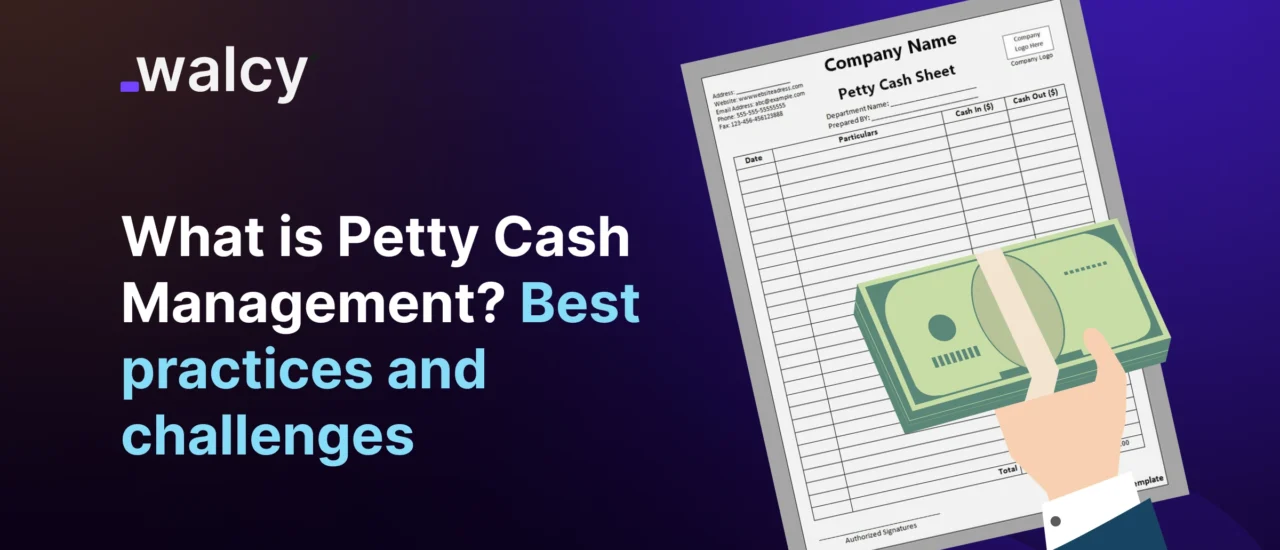Petty cash is the small amount of cash a company possesses to make payments for minor expenses originating from daily operations. In addition, this list may include office supplies, postage, and similar purchases in small emergencies. Proper petty cash management means the funds are appropriately utilized, accurately recorded, and replenished as required.
The following paper will elaborate on the following fundamental aspects of petty cash management in detail: petty cash handling, imp rest, the petty cash management process, petty cash control, and advantages arising from the usage of petty cash management software.
How Petty Cash Management Works?
Petty Cash Management is defined as the processes for managing the allocation, disbursement, and replenishment of petty cash within an organization. While the absolute amounts of cash are small, a petty cash management system requires a disproportionately high degree of accuracy and strong controls against misappropriation or errors.
A sound petty cash system enables small yet important expenses to be easily and speedily covered without resorting to formal requisitions or check processing, which may be disproportionately cumbersome for the amounts involved.
Importance of Effective Petty Cash Management
Though petty cash forms the smallest proportion of the company’s finances, poor management can give in to huge losses, including unaccounted and fraudulent means. Effective petty cash management in the following ways:
Maintaining accurate records: proper documentation ensures that all expenses are recorded, thus providing a broader way to monitor and audit petty cash usage.
Easily accessible and transparent expense: Petty cash is easily accessible when necessary and not misused or stolen because of strict controls and constant vigil.
Availability of Petty Cash: The availability of petty cash ensures that small expenses will not disrupt operations while waiting for approval through more formal channels.
Budget Control: With a petty cash fund, businesses can keep an eye on not overspending on little, superfluous items by knowing exactly how much petty cash was paid out and for what.
Key Elements in Petty Cash Management
The important points of Petty Cash Management are as follows:
Establishment of a Petty Cash Fund
The foremost step to managing petty cash is to establish a petty cash fund. The amount that is going to be held within the company is to be estimated and then the procedure for issuance is to be settled. A typical business firm appoints a petty cash custodian to handle the funds.
This figure depends upon the amount and nature of the business. A small amount of $100 to $500 is considered for a small business, but a significant amount, in any manner, is required by larger businesses.
The Imprest System
The Imprest management system is one of the common systems for the management of petty cash. This involves keeping an exact amount of money for petty cash, and when expenses start being made from that, a record is kept and replaced with the actual amount it was previously set for. This system retains control and facilitates tracking and reconciling the funds of petty cash expenditure.
For example, after a company creates a $500 petty cash account and depletes it for about $200 worth of small company items, the account is replenished again to $500 by transferring the physically spent money and withdrawing another $200 from the company-registered bank account. The procedure is repeated, and petty cash is regularly kept and reported:
Steps of Maintaining Petty Cash
The petty cash management procedures are the firm’s various dos and don’ts governing petty cash utilization within the organization. These entail, but are not limited to:
Authorization: Lay down the persons at various levels who can approve a petty cash disbursement. This would avoid unauthorized utilization of cash.
Documentation: Every payment should be supported by a receipt/voucher detailing such an expense. It goes on record.
- Reconciliation: A comparison needs to be done of the petty cash amount with the expenditures that occurred and the still unpaid amount to make sure that the fund is still composed of the same amount as recorded. Any difference should be investigated forthwith.
- Replenishment: At each point in time that the petty cash fund becomes average; in amount, the custodian requests the replenishment simultaneously with the respective documentation of the previous expenditures.
The above-said mechanisms ensure consistency and transparency in the petty cash mechanism, making sure that no error or fraud goes by
Monitoring of petty cash:
It includes the recurring supervision of the petty fund, ensuring its proper use, which might include the following:
Periodic Audits: These could be surprise audits on petty cash to ascertain that the cash available indeed tallies the transactions as recorded.
- Spending Analysis: It could involve examining the types of expenses being covered by petty cash to identify trends or areas where costs could be reduced.
- Usage Restrictions: Limiting the cost that can be spent out for a single purchase or in a specific time frame to prevent overspending.
Monitoring is a key important concept in Petty Cash Management, which ensures integrity and that the monies used are put into proper utilization.
Utilizing Petty Cash Management Software
Due to the growth of technology in business, most companies have increasingly resorted to petty cash management software to facilitate automation and smoothness in the process. Various advantages can be derived from such software, which includes but is not limited to the following:
Automation: Automating the process of petty cash reduces manual work, hence making tracking and reconciliation of expenditure easier.
Real-time Tracking: Some software provides for real-time tracking of petty cash expenditure, hence delivering instant insight into where money is being used.
Reporting and Analysis: Petty cash management software can generate detailed reports, analyzing spending patterns and even suggesting possible ways to make improvements in spending patterns.
Enhanced security: The digital records of petty cash make it harder for an occurrence of fraud for any business. All of its transactions are securely stored and are likewise easily accessible for audits.
Popular tools that offer proper petty cash software management include Xero, QuickBooks, and Expensify, among others, which come with numerous features to meet every business requirement.
Best Practices to Manage Petty Cash
To ensure a harmonious and effective petty cash system you should:
Set Clear Policy: Define clearly the expenditures that would be paid by petty cash, make it known to all other employees to avoid misuse, and sure petty cash is used in appropriate causes.
Reconciliation Runs: The reconciliation of petty cash funds has to be a regular practice, preferably once a month, to keep the transactions updated. This will help trace discrepancies right at initial occurrences and will maintain the fund balance.
Authorization to Limited People: Petty cash funds should have access by very few people in an organization. This should help reduce the chances of it being misused and make the disbursement of cash easy to trace to which party.
Record: All transactions should be recorded using petty cash vouchers. The petty cash voucher will outline the date, amount, expenditure purpose, and the signature of the person who authorizes the disbursement.
Audit: Regular audits should be conducted and sometimes surprise audits to ensure that the petty cash is being handled right, and no illegal dealings have run the fund dry.
Train Employees: Train all the employees having access to petty cash, providing them with all the necessary knowledge on the policies and processes that are put in place. There will be few errors by following this, and everyone will be working with the same set of guidelines.
Challenges in Petty Cash Management
With a properly designed system, normally businesses can face some challenges in maintaining petty cash. The following are some of the significant issues:
Misuse of funds: Without strict controls, petty cash can be abused for personal use or unauthorized purchases. Regular monitoring and clear policies can prevent this.
Lack of documentation: Not collecting receipts or failing to document expenses can create a discrepancy and be difficult to reconcile. All employees should be stressed about the essence of documentation.
Overuse: Petty cash at times can be abused and overspent on what normally should be done through other more formal and proper types of expenses. Clearly define what petty cash should and shouldn’t be used for.
Petty cash Usages: At times can be abused and overspent on what normally should be done through other more formal and proper types of expenses. Clearly define what petty cash should and shouldn’t be used for.
Reconciliation Problems: if not done properly and regularly, reconciling at the end of a period becomes a very harrowing exercise that may be irresolvable. Create an effective, regular reconciliation plan.
The Future of Petty Cash Management
As businesses become more digital with their overall work systems, the future of Petty Cash Management may take them to the next level with automation and the integration of other systems, particularly those that are financial.
Look for these trends to play out: More Automation With ever-more-sophisticated petty cash management software, the trend will be to even greater automation of tracking, reconciling, and reporting on petty cash expenditures.
Mobile Solutions: There will be visible growth in mobile applications for handling petty cash with ease. In this manner, employees can carry out a transaction anytime, anywhere, and paper transaction records will decrease.
Integration with Financial Systems: Gradually, petty cash management features will get integrated with other broader financial systems, including accounting and ERP software, to view a more end-to-end view of financials for better efficiency.
Added Security: The more this digital solution is used, the more security features will be devised against fraud and unauthorized access to petty cash funds.
Conclusion
For this reason, petty cash management is very important to the financial management of any business entity. With well-crafted procedures, meticulously controlled usage, and modern tools to support them, such as petty cash management software, companies will be in a position to confirm that their petty cash funds are properly accounted for efficiently and safely. This doesn’t just prevent fraud and errors—this ensures that those small but important expenses are covered in plenty of time to keep the business running smoothly.
The organization can, by following the best guidelines and practices understood from this guide, easily set up a sound petty cash management system that works well and is easy to maintain.
Read about: Transferring Money To Foreign Bank Account. Essential Tips To Know.
Do follow us on Facebook and LinkedIn, to stay connected with us.



